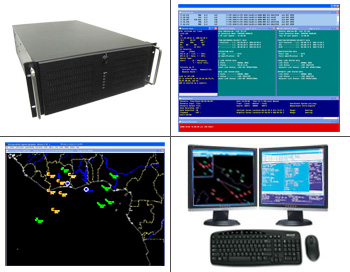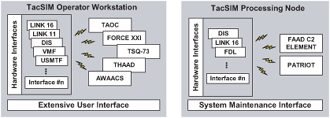Tactical Communications Simulator

RSI’s Tactical Communications Simulator (TacSIM) is an off-the-shelf PC based tactical communications simulation system supporting the systems integration, test and training missions for U.S. and allied armed forces, and major defense suppliers around the world. TacSIM has been validated by the U.S. Army for use in interoperability testing on Link 16 (TADIL J), Link 11 (TADIL A) and Link 11B (TADIL B). TacSIM is highly configurable by utilizing RSI’s Simulation Core user interface package and then layering multiple tactical data link, simulation data link and/or radar interfaces from RSI’s Interface Package Library (IPL). New customer application-specific requirements are easily accomodated.
TacSIM is a PC based tactical communications and radar simulation system that uses ruggedized, commercial off-the-shelf hardware conÞgurations for enhanced reliability and durability. TacSIM functions much like an actual Tactical Data System (TDS) except that the Simulation Object Database from which messages are generated is initiated through manual operator actions, scenario events, and/or simulation data link input (e.g. DIS) instead of from sensor inputs. External interfaces configured into the TacSIM independently scan the Simulation Object Database and generate the appropriate primary and amplifying messages for each object. Message generation is based on the visibility of the object (e.g. radar coverage area), availability of data, and requirements of the associated specification (e.g. MIL-STD-6016E). Data received over a configured external interface is validated for errors and processed for automatic link responses (R 2 shifts, ID conflict processing, command processing, etc.), presentation of new data in hook readouts, real-time data reduction, and automatic alerts. Non-periodic message traffic such as Data Update Requests, ID Differences, etc. are generated in response to operator actions (and scenario events) as well as in response to received messages.
- Data Links
- Radars
- I/O Protocols and Standards
- Datasheet
- Link 16
(MIL-STD-6016, STANG 5516, JTIDS TIDIP) - Link 11, Link 11B
(MIL-STD-6011, STANG 5511, JCS Pub6) - NATO Link1
(STANG 5501) - ATDL-1
(MIL-STD-6013) - FAAD Data Link
- NATO Link 14
- USMTF
- TIBS
- Variable Message Format
- International Data Link
- Unclassified Data Link
- Missile Battery Data Link
- Lateral Tell
- Forward Tell
- TESS
- ICAO
- Simulated Data Links:
- DIS
- TCL
- Forwarding:
- Link 16
 Link 11/11B
Link 11/11B
- FAAD/GBS
- CD2
- AN/APG-71
- AS/APS-138
- AN/APY-2
- AN/APX-76
- AN/APX-100
- AN/APX-103
- AN/ARN-118
- AN/ARN-118A
- AN/ASN-130
- AN/FPS-117 (LPR)
- AN/MPQ-51 (ROR)
- AN/MPQ-55(CWAR)
- AN/MPQ-57
- AN/TPS-32
- AN/TPS-43E (DAR)
- AN/TPS-70
- AN/TPS-75
- AN/TPS-46
- AN/UPX-23
- AN/UPX-27
- IHAWK Phase III
AN/MPQ-50 (PAR)
AN/MPQ-61 (HIPIR)
AN/MPQ-62 (CWAR)
M192 Launcher
- SPS-48C
- SPS-96/125
- RS-232
- RS-422
- RS-449
- RS-485
- EIA-530
- EIA-530A
- SCRAMNET
- V.35
- V.36
- X.25
- HDLC
- ADDSI
- TCP, UDP, Multicast
Pull-down and context specific pop-up menus facilitate definition of the simulation environment which comprises moving and stationary entities. Entity types include air, land, surface, and subsurface surveillance objects, unit platforms/radar sites, missiles (ballistic and non-ballistic) and EA/ES objects. Pre-defined world maps, user defined map areas, and digital terrain maps provide enhanced visualization. Extensive user-friendly controls allow operators to filter the tactical situation displays as well as both real-time and post-test data reduction providing optimal data visibility for observation and analysis. TacSIM’s scenario generation facility allows users to automatically capture all operator actions as a scenario. Scenario files are plain ASCII text and are easily modiÞed with any text editor. Users retain full interactive control of TacSIM during execution of a scenario and may perform any mix of scenario driven and manually initiated events providing real-time control of the simulation environment at all times.

 The number of external interfaces supported by a single workstation is limited only by the number of hardware
slots available for interface cards. When more external interfaces are required, TacSIM can be configured as a
distributed network supporting multiple integated workstations and processing nodes. In this configuration, TacSIM
provides distributed processing and operator controls while maintaining fully integrated situation awareness and data
availabilty at each workstation. Additional processing nodes can easily be added when elments of the system-under-test
are physically separated.
The number of external interfaces supported by a single workstation is limited only by the number of hardware
slots available for interface cards. When more external interfaces are required, TacSIM can be configured as a
distributed network supporting multiple integated workstations and processing nodes. In this configuration, TacSIM
provides distributed processing and operator controls while maintaining fully integrated situation awareness and data
availabilty at each workstation. Additional processing nodes can easily be added when elments of the system-under-test
are physically separated.